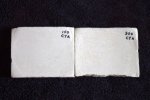Contrary to some misinformation that has lately been floating around in the pool industry, high cyanuric acid (stabilizer) levels do not cause gray discoloration, or white spotting (“spot etching” as some incorrectly call it) in plaster swimming pools, no matter what. And there are several studies that have documented that.
The NPC/NPIRC Cal Poly Phase 4 study (2006-2007) showed that 250 ppm of cyanuric acid (CyA) didn’t cause gray discolorations or white spotting. In fact, in comparison to pools with zero, 50 ppm, and 100 ppm of CyA, the plaster pools with 250 ppm CyA looked the best overall after ten months, demonstrating that high CyA does not cause discolorations.
A study by onBalance included placing a quality plaster coupon into balanced LSI or CSI water with 150 ppm of CyA, and an identical coupon into aggressive water (low TA) with 300 ppm of CyA. They were left there for one year. The picture below shows that the coupon submerged in 150 ppm CyA remained uniformly white and smooth (non-etched). Although it is hard to see, the coupon submerged in 300 ppm CyA (and was aggressive) had slight uniform etching and some exposed aggregate showing at surface. Note that neither of the plaster coupons resulted in gray mottling or white spotting.

The Dr. Dow Whitney study (University of Florida, 1990) concluded that Cyanuric acid alone did not appear to be the cause of leaching even at 500 ppm!
The 2004-2005 Arch Study provided further evidence that high CyA levels don’t cause gray discoloring or white spotting of pool plaster. Their study did show uniform etching (degradation) of the plaster coupons due to the water being aggressive, but not from high CyA only. It appears that the alkalinity was not adjusted upward to balance the water (per the LSI) when higher CyA levels (250 ppm) were maintained which means the water was LSI (or CSI) aggressive, and thus, would cause some etching due to the water being aggressive. And not because of the presence of CyA.
It is acknowledged that discoloration, etching, and other problems may occur if un-dissolved CyA is allowed to sit on a pool surface for any length of time.
The NPC/NPIRC Cal Poly Phase 4 study (2006-2007) showed that 250 ppm of cyanuric acid (CyA) didn’t cause gray discolorations or white spotting. In fact, in comparison to pools with zero, 50 ppm, and 100 ppm of CyA, the plaster pools with 250 ppm CyA looked the best overall after ten months, demonstrating that high CyA does not cause discolorations.
A study by onBalance included placing a quality plaster coupon into balanced LSI or CSI water with 150 ppm of CyA, and an identical coupon into aggressive water (low TA) with 300 ppm of CyA. They were left there for one year. The picture below shows that the coupon submerged in 150 ppm CyA remained uniformly white and smooth (non-etched). Although it is hard to see, the coupon submerged in 300 ppm CyA (and was aggressive) had slight uniform etching and some exposed aggregate showing at surface. Note that neither of the plaster coupons resulted in gray mottling or white spotting.

The Dr. Dow Whitney study (University of Florida, 1990) concluded that Cyanuric acid alone did not appear to be the cause of leaching even at 500 ppm!
The 2004-2005 Arch Study provided further evidence that high CyA levels don’t cause gray discoloring or white spotting of pool plaster. Their study did show uniform etching (degradation) of the plaster coupons due to the water being aggressive, but not from high CyA only. It appears that the alkalinity was not adjusted upward to balance the water (per the LSI) when higher CyA levels (250 ppm) were maintained which means the water was LSI (or CSI) aggressive, and thus, would cause some etching due to the water being aggressive. And not because of the presence of CyA.
It is acknowledged that discoloration, etching, and other problems may occur if un-dissolved CyA is allowed to sit on a pool surface for any length of time.
Last edited:


